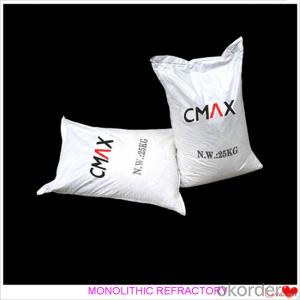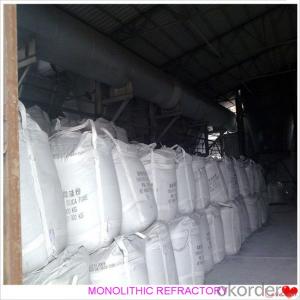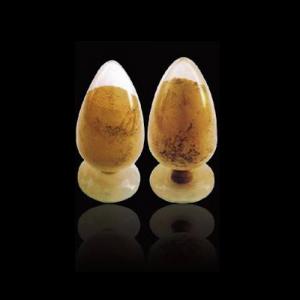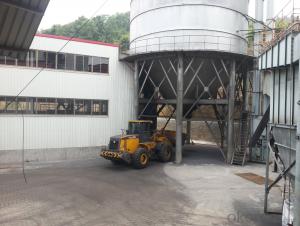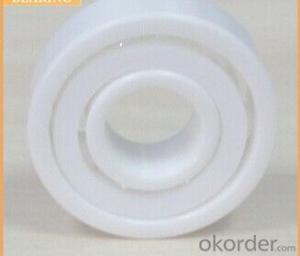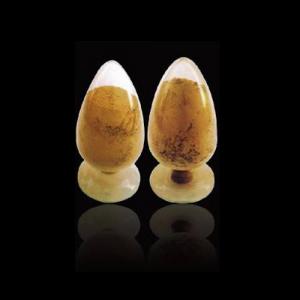Corundum Castable For Fireplace and Industrial Furnace in Iron and Steel
- Loading Port:
- China main port
- Payment Terms:
- TT OR LC
- Min Order Qty:
- 100 kg
- Supply Capability:
- 3000000 kg/month
OKorder Service Pledge
OKorder Financial Service
You Might Also Like
Corundum Castable For Fireplace and Industrial Furnace in Iron and Steel
Product Description:
Corundum castable is manufactured according to international standards. The product is famous for its excellent abrasion resistance and low thermal conductivity. Further, these can be provided in different specifications as required by the clients. The Corundum castables are used high purity raw materials and additives as the main material, and made of under superfine powder adding technology.
Product Advantages:
The material has excellent structural stability and air tightness, and has high physical and chemical properties, also has a fine working ability.They should be used with the same material products.
Product Applications:
For feature of Corundum castable, they have excellent abrasion resistance, thermal shock resistance, high-temperature resistance, anti-corrode and have high intensity.
Designed for refractory lining of blast furnace iron and slag runners, skimmers and soon
They can be used in troughs of small and mid size BFs and in all positions of the troughs where fast tapping is required.
Product Specifications:
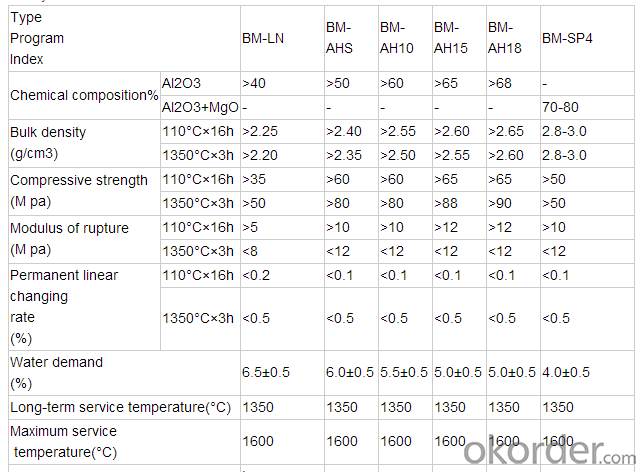
FAQ:
1. How you can control your quality?
For each production processing, we have complete QC system for the chemical composition
and Physical properties. After production, all the goods will be tested, and the quality certificate
will be shipped along with goods.
2. What's your delivery time?
It usually needs about 20days- 45 days after receiving the deposit.
3. Do you provide free samples?
Yes, we can provide a free sample for testing, If we have sample in stock,
The quantity based on the material type, The buyer should bear all the shipping costs.
4. What's your payment terms?
We can accept 30% deposit, 70% balance before shipment for ordrs over $ 2000.
5. Can we visit your Company?
Yes, certainly. You are very welcome to China and we will be honored to have a customer and friend.
Product Picture:
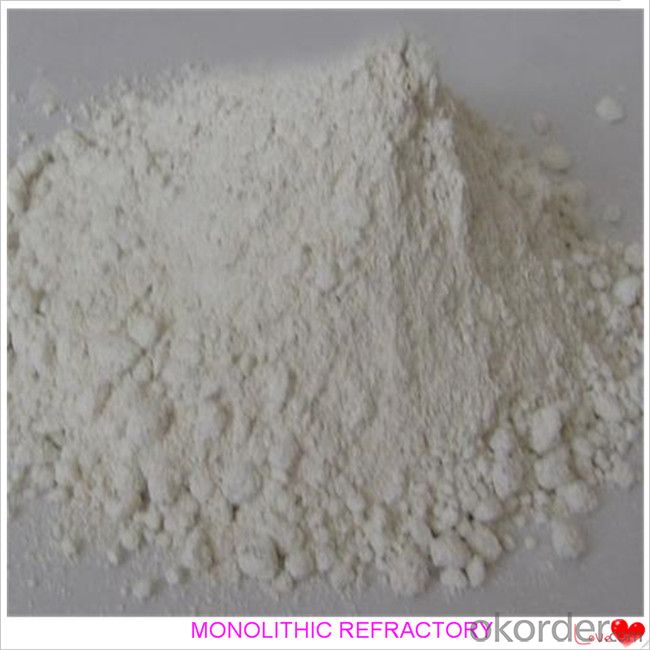
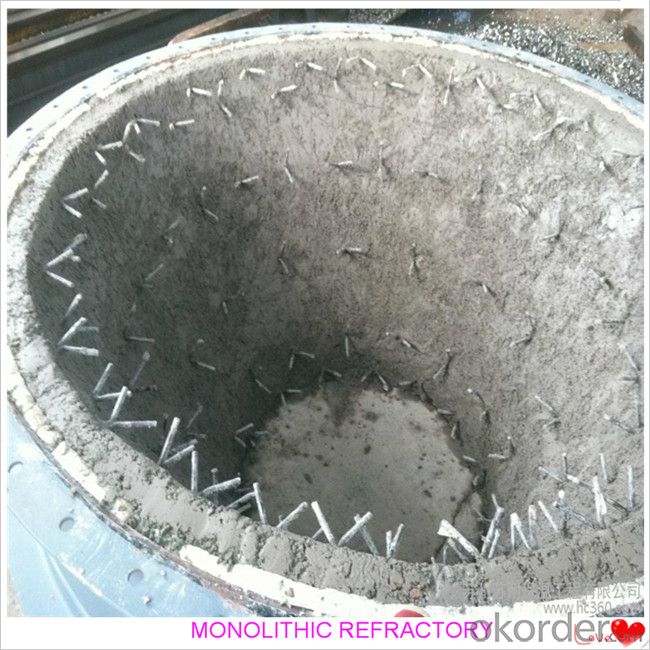
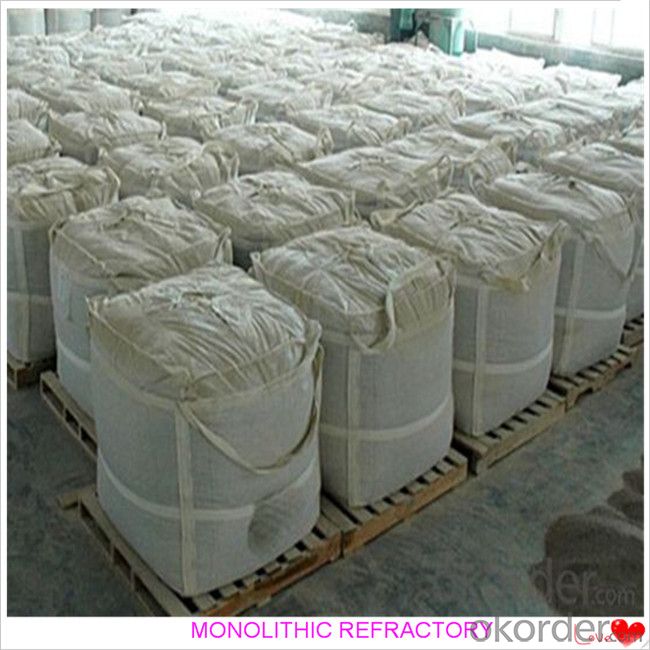
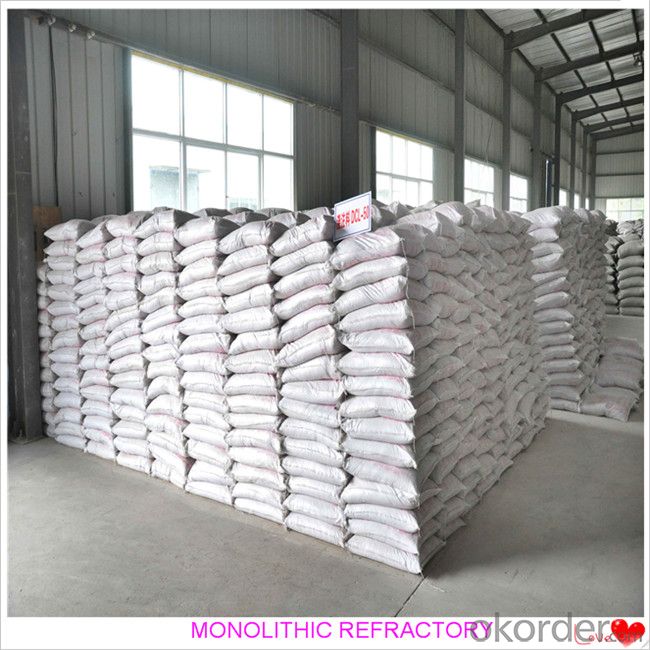
- Q:How do monolithic refractories contribute to the overall efficiency of steel ladle operations?
- Monolithic refractories play a crucial role in enhancing the overall efficiency of steel ladle operations. They provide a protective lining that withstands extreme temperatures, chemical reactions, and mechanical stresses during the steelmaking process. This lining helps to retain heat and prevent heat loss, ensuring better temperature control and reducing energy consumption. Additionally, monolithic refractories minimize metal penetration and slag adhesion, improving ladle cleanliness and reducing the risk of clogging or blockages. Overall, the use of monolithic refractories in steel ladles promotes higher productivity, improved steel quality, and cost-effective operations.
- Q:What are the specific requirements of monolithic refractories for blast furnace applications?
- Monolithic refractories used in blast furnace applications must possess specific attributes to withstand the extreme conditions within the furnace. These requirements include high thermal conductivity, excellent thermal shock resistance, superior erosion and abrasion resistance, and good chemical resistance to withstand the corrosive nature of molten iron and slag. Additionally, they should have low porosity to prevent the penetration of molten metal, high mechanical strength to withstand the weight of the burden, and good dimensional stability to maintain their shape and integrity during operation.
- Q:How are monolithic refractories manufactured?
- Monolithic refractories are manufactured by combining various raw materials, such as aggregates, binders, and additives, with water to create a workable mixture. This mixture is then shaped into the desired form, either by casting, gunning, or ramming. Afterwards, the shaped refractory is dried and fired at high temperatures to achieve the desired strength and thermal properties. The manufacturing process of monolithic refractories allows for flexibility in design and installation, making them suitable for a wide range of applications.
- Q:What are the specific requirements of monolithic refractories for steel ladle purging applications?
- Monolithic refractories used in steel ladle purging applications have specific requirements to ensure optimal performance and durability. Firstly, these refractories need to have high thermal stability and resistance to thermal shock due to the extreme temperatures involved in the steelmaking process. This is important to prevent any cracking or spalling of the refractory lining. In addition, monolithic refractories for ladle purging applications should have excellent corrosion resistance against molten steel and slag. They need to withstand the aggressive chemical environment without any significant deterioration, as this could lead to contamination of the steel and affect its quality. Another important requirement is good erosion resistance. The refractories should be able to withstand the high velocity of the purging process, where argon or other gases are injected into the ladle to remove impurities. This erosion resistance ensures that the refractory lining remains intact and does not wear away during operation. Furthermore, monolithic refractories for ladle purging applications should have low porosity and high density. This prevents the penetration of molten steel and slag into the refractory lining, reducing the risk of thermal spalling and corrosion. Lastly, these refractories should have good thermal conductivity to efficiently transfer heat from the steel to the refractory lining, allowing for better temperature control and energy efficiency during the purging process. Overall, the specific requirements of monolithic refractories for steel ladle purging applications include high thermal stability, corrosion resistance, erosion resistance, low porosity, high density, and good thermal conductivity. Meeting these requirements ensures the refractories can withstand the harsh conditions of the steelmaking process, maintain their integrity, and contribute to the production of high-quality steel.
- Q:Can monolithic refractories be used for the lining of reheating furnaces and walking beam furnaces?
- Yes, monolithic refractories can be used for the lining of reheating furnaces and walking beam furnaces. Monolithic refractories are a type of refractory material that is characterized by its ability to be cast or gunned into place, rather than being made up of individual bricks or precast shapes. This makes them highly versatile and adaptable for various furnace applications, including reheating furnaces and walking beam furnaces. Reheating furnaces are used to heat metal products to a specific temperature before further processing, such as rolling or forging. The lining of these furnaces is subjected to high temperatures, thermal cycling, and mechanical stress. Monolithic refractories are well-suited for these conditions, as they have excellent thermal shock resistance and can withstand rapid temperature changes without cracking or spalling. Walking beam furnaces are used in the steel industry for the continuous heating and transport of steel slabs or billets. These furnaces require a lining material that can withstand the abrasion and mechanical stress caused by the movement of the material. Monolithic refractories with high abrasion resistance and good mechanical strength are ideal for the lining of walking beam furnaces. Additionally, monolithic refractories offer other advantages such as easy installation, reduced downtime for repairs, and improved energy efficiency. They can be tailored to specific furnace designs and can be easily repaired or replaced when necessary. In conclusion, monolithic refractories are a suitable choice for the lining of reheating furnaces and walking beam furnaces due to their ability to withstand high temperatures, thermal cycling, mechanical stress, and abrasion. Their versatility, ease of installation, and repair make them a preferred option for these furnace applications.
- Q:How do monolithic refractories contribute to the overall safety of iron and steel operations?
- Monolithic refractories play a crucial role in ensuring the overall safety of iron and steel operations. These refractories are designed to withstand extreme temperatures, chemical reactions, and mechanical stresses, providing a protective barrier to the furnaces, ladles, and other equipment used in these operations. By maintaining the integrity of the refractory lining, monolithic refractories prevent leaks, minimize the risk of thermal shock, and reduce the chances of equipment failure or accidents. This helps to safeguard the workers, prevent damage to the infrastructure, and ensure the uninterrupted production of iron and steel, thus contributing to the overall safety of the operations.
- Q:What are the recommended curing times for monolithic refractories?
- The curing times for monolithic refractories can differ depending on the type of refractory and its specific application. Following the manufacturer's guidelines for curing times is crucial to ensure proper setting and development of the refractory material. For traditional castable refractories, the typical curing time ranges from 24 to 48 hours. During this period, it is important to control temperature and humidity conditions to allow for hydration and hardening of the castable. This curing time is essential to achieve the desired strength and durability of the refractory lining. In contrast, low cement or ultra-low cement castables may need a longer curing time due to their reduced water content. These refractories often require a curing period of 48 to 72 hours to allow for adequate bonding and solidification. For gunning mixes or shotcrete applications, the curing time may be shorter, usually around 8 to 12 hours. This faster curing process is facilitated by adding accelerators to the mix, which promote rapid setting and hardening. It is important to remember that these recommended curing times are general guidelines, and specific recommendations may vary depending on factors such as ambient temperature, humidity, and the specific refractory material used. Therefore, it is advisable to consult the manufacturer's instructions or seek guidance from a refractory specialist to ensure optimal curing and performance of the monolithic refractory.
- Q:How do monolithic refractories withstand the chemical attacks in aluminum furnace applications?
- Monolithic refractories are able to withstand chemical attacks in aluminum furnace applications due to their unique composition and properties. These materials are designed to have high resistance to the corrosive effects of molten aluminum and other chemicals present in the furnace environment. Firstly, monolithic refractories are made from a combination of different minerals, such as alumina, silicon carbide, and zirconia, which have high melting points and excellent chemical stability. These minerals act as a barrier between the corrosive substances and the underlying structure, preventing them from penetrating or damaging the refractory lining. Additionally, monolithic refractories are typically formulated with high levels of alumina, which provides them with exceptional resistance to chemical attacks. Alumina has a strong affinity for oxygen, forming a stable oxide layer on the surface of the refractory material, acting as a protective barrier against corrosive elements. This oxide layer also helps to reduce the rate of penetration of corrosive substances into the refractory lining. Moreover, monolithic refractories are often designed with a dense microstructure and low porosity. This ensures that there are fewer pathways for the corrosive substances to penetrate and attack the refractory material. The denser the material, the less susceptible it is to chemical attacks. Furthermore, monolithic refractories can be further enhanced by adding additives or binders that improve their resistance to chemical attacks. These additives can include various organic or inorganic materials that provide additional protection against corrosive substances. Overall, monolithic refractories are specifically engineered to withstand the harsh conditions of aluminum furnace applications. Their unique composition, high alumina content, dense microstructure, and resistance-enhancing additives all contribute to their ability to withstand chemical attacks and prolong the lifespan of the refractory lining in aluminum furnaces.
- Q:How do monolithic refractories withstand the chemical attacks in copper smelting applications?
- Due to their unique properties and composition, monolithic refractories are capable of enduring chemical attacks in copper smelting applications. These refractories are specifically engineered to resist the harsh and corrosive environment found in copper smelting processes. To begin with, monolithic refractories are crafted from high-quality materials such as alumina, silica, and magnesia. These materials possess high melting points and chemical stability. Carefully selected, they are able to withstand the corrosive effects of copper smelting, including the presence of sulfur compounds and acidic gases. The refractory's composition also includes various additives and bonding agents that enhance its resistance to chemical attacks. In addition, monolithic refractories exhibit exceptional thermal shock resistance. This means they can withstand rapid temperature changes without cracking or spalling. In copper smelting applications, where extreme temperatures are involved, this refractory quality is crucial in preventing the formation of cracks and ensuring long-term performance. Furthermore, monolithic refractories possess a dense and compact structure. This structure serves as an effective barrier against the infiltration of molten copper and other corrosive substances. By preventing the penetration of chemical attacks, the refractory lining's durability and longevity are ensured. Moreover, monolithic refractories offer superior erosion resistance. This is particularly important in copper smelting applications, where high-velocity gases and flows of molten metal can cause erosion of the refractory lining. The refractory's erosion resistance prevents the degradation of the lining and maintains its structural integrity. In conclusion, monolithic refractories are specially designed to withstand the chemical attacks encountered in copper smelting applications. Through the use of high-quality materials, the incorporation of additives, and the possession of excellent thermal shock resistance, density, and erosion resistance, these refractories provide a reliable and durable lining that can endure the harsh conditions of copper smelting processes.
- Q:How do monolithic refractories resist high temperatures?
- Monolithic refractories are designed to resist high temperatures due to their unique composition and structure. These refractories are made from a single piece or material, unlike traditional refractory bricks that are composed of multiple pieces. The main reason why monolithic refractories can resist high temperatures is their high melting point. These refractories are made from materials such as alumina, silica, and magnesia, which have high melting points ranging from 1650°C to 2000°C. This means that they can withstand extreme temperatures without undergoing significant deformation or melting. Furthermore, monolithic refractories possess excellent thermal stability. They have low thermal conductivity, which means they can effectively insulate against heat transfer. This property allows the refractories to maintain their structural integrity even when exposed to rapid temperature changes or thermal shocks. In addition, the monolithic nature of these refractories provides them with enhanced resistance to thermal stress. Unlike traditional refractory bricks, monolithic refractories do not have joints or seams that can be vulnerable to thermal expansion and contraction. This makes them more resistant to cracking or spalling when subjected to high temperatures. Moreover, monolithic refractories can form a protective layer or slag on their surface when exposed to high temperatures. This slag acts as a barrier and prevents direct contact between the refractory material and the hot gases or molten metals, reducing the risk of chemical reactions or corrosion. Overall, the combination of high melting point, thermal stability, resistance to thermal stress, and the ability to form protective slag makes monolithic refractories highly effective in resisting high temperatures. They are widely used in various industries, including steel, cement, glass, and petrochemical, where they are exposed to extreme heat conditions.
1. Manufacturer Overview |
|
|---|---|
| Location | |
| Year Established | |
| Annual Output Value | |
| Main Markets | |
| Company Certifications | |
2. Manufacturer Certificates |
|
|---|---|
| a) Certification Name | |
| Range | |
| Reference | |
| Validity Period | |
3. Manufacturer Capability |
|
|---|---|
| a)Trade Capacity | |
| Nearest Port | |
| Export Percentage | |
| No.of Employees in Trade Department | |
| Language Spoken: | |
| b)Factory Information | |
| Factory Size: | |
| No. of Production Lines | |
| Contract Manufacturing | |
| Product Price Range | |
Send your message to us
Corundum Castable For Fireplace and Industrial Furnace in Iron and Steel
- Loading Port:
- China main port
- Payment Terms:
- TT OR LC
- Min Order Qty:
- 100 kg
- Supply Capability:
- 3000000 kg/month
OKorder Service Pledge
OKorder Financial Service
Similar products
New products
Hot products
Related keywords

